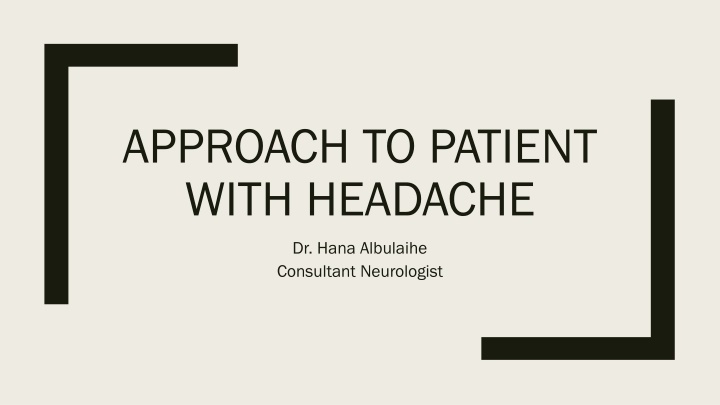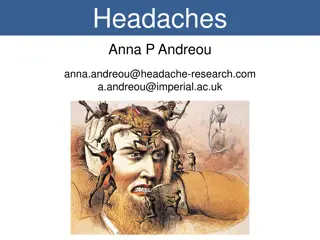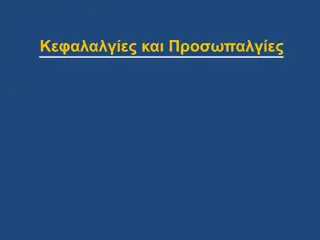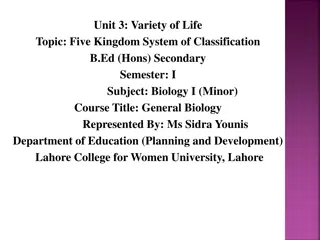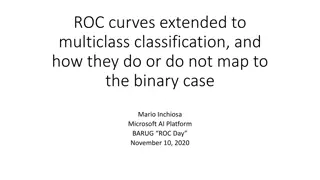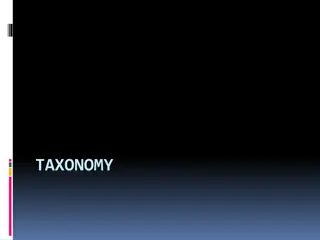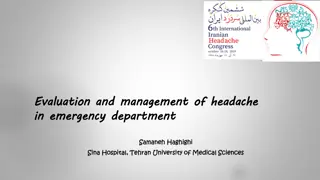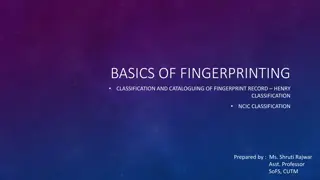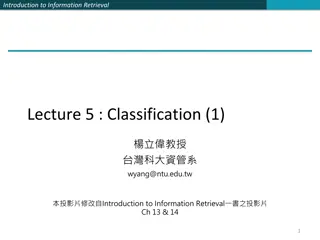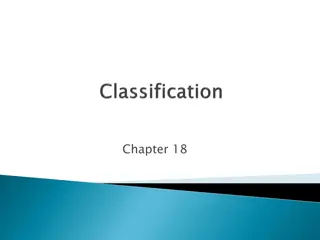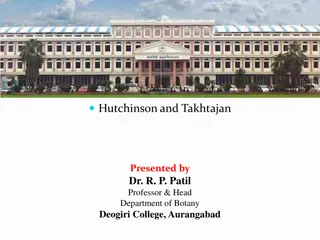Headaches and Their Classification
Pain-sensitive structures in the head, classification of headaches, common primary and secondary headaches, and an approach to patients experiencing headaches are discussed by Dr. Hana Albulaihe, a Consultant Neurologist.
Download Presentation

Please find below an Image/Link to download the presentation.
The content on the website is provided AS IS for your information and personal use only. It may not be sold, licensed, or shared on other websites without obtaining consent from the author.If you encounter any issues during the download, it is possible that the publisher has removed the file from their server.
You are allowed to download the files provided on this website for personal or commercial use, subject to the condition that they are used lawfully. All files are the property of their respective owners.
The content on the website is provided AS IS for your information and personal use only. It may not be sold, licensed, or shared on other websites without obtaining consent from the author.
E N D
Presentation Transcript
APPROACH TO PATIENT WITH HEADACHE Dr. Hana Albulaihe Consultant Neurologist
Objectives Pain sensitive structures in the head Classification of headache Most common primary headaches Most common secondary headaches Approach to patient with headache Management of common headache types
Headache is pain in any part of the head, including the scalp, face, orbitotemporal area and interior of the head. Headache is one of the most common reasons patients seek medical attention. It is due to activation of pain-sensitive structures in or around the brain, skull, face, sinuses, or teeth.
Pain Sensitive structures in Brain : Pain Sensitive structures in Brain : Intracranial Intracranial : 1. Cranial venous sinuses with afferent veins 2. Arteries at base of brain and arteries of dura including middle meningeal artery 3. Dura around venous sinuses and vessels 4. Falx cerebri
Extracranial : Extracranial : 1. Skin 2. Scalp appendages 3. Periosteum 4. Muscles 5. Arteries 6. Mucosa
Nerves : Nerves : 1. Trigeminal (Fifth cranial nerve) 2. Facial (seventh cranial nerve) 3. Vagal (Tenth cranial nerve) 4. Glossopharyngeal (Ninth cranial nerve) 5. Second and Third cranial nerves
Classification Classification Primary headache. Secondary headache.
Classification Classification Primary headache disorders: Migraine. Cluster headache. Chronic paroxysmal hemicrania. Hemicrania continua. Tension-type headache.
Evaluation Evaluation Determining whether a secondary headache is present. Check for symptoms that suggest a serious cause. If no cause or serious symptoms are identified, evaluation focuses on diagnosing primary headache disorders.
History History History of present illness History of present illness: Headache location. Duration. Severity. Onset. Quality ( throbbing, constant, intermittent, pressure-like). Exacerbating and remitting factors ( head position, time of day, sleep, light, sounds, physical activity, odors, chewing).
History History History of present illness History of present illness: Previous or recurrent headaches. The previous diagnosis (if any). Whether the current headache is similar or different. For recurrent headaches, age at onset, frequency of episodes, temporal pattern (including any relationship to phase of menstrual cycle), and response to treatments (including OTC treatments).
History History Headaches that have recurred since childhood or young adulthood suggest a primary headache disorder. If headache type or pattern clearly changes in patients with a known primary headache disorder, secondary headache should be considered.
History History Review of systems: Review of systems: Vomiting: Migraine or increased intracranial pressure Fever: Infection (eg, encephalitis, meningitis, sinusitis) Red eye and/or visual symptoms (halos, blurring): Acute angle-closure glaucoma Visual field deficits, diplopia, or blurring vision: Ocular migraine, brain mass lesion, or idiopathic intracranial hypertension Lacrimation and facial flushing: Cluster headache Rhinorrhea: Sinusitis Pulsatile tinnitus: Idiopathic intracranial hypertension
History History Review of systems: Review of systems: Preceding aura: Migraine. Focal neurologic deficit: Encephalitis, meningitis, intracerebral hemorrhage, subdural hematoma, tumor, or other mass lesion. Seizures: Encephalitis, tumor, or other mass lesion. Syncope at headache onset: Subarachnoid hemorrhage. Myalgias and/or vision changes (in people > 55 yr): Giant cell arteritis.
History History Past medical history: Past medical history: exposure to drugs, substances (particularly caffeine), and toxins recent lumbar puncture; immunosuppressive disorders or IV drug use (risk of infection);
History History Past medical history: Past medical history: Hypertension (risk of brain hemorrhage). Cancer (risk of brain metastases). Trauma, coagulopathy, or use of anticoagulants or ethanol (risk of subdural hematoma). Family and social history of headaches, particularly because migraine headache may be undiagnosed in family members.
Physical examination Physical examination Vital signs, including temperature. General appearance (eg, whether restless or calm in a dark room) is noted. Full neurologic examination are done. The scalp is examined for areas of swelling and tenderness. The ipsilateral temporal artery is palpated. Temporomandibular joints are palpated for tenderness and crepitance while the patient opens and closes the jaw.
Physical examination Physical examination The eyes and periorbital area ( lacrimation, flushing, and conjunctival injection. Pupillary size and light responses, extraocular movements, and visual fields. The fundi for evidence of papilledema. If patients have vision-related symptoms or eye abnormalities. visual acuity. The oropharynx for swellings, and the teeth for tenderness. Neck flexion to detect discomfort or stiffness indicating meningismus. The cervical spine for tenderness.
Red flags Red flags Neurologic symptoms or signs ( altered mental status, weakness, diplopia, papilledema, focal neurologic deficits) Immunosuppression or cancer. Meningismus. Onset of headache after age 50. Thunderclap headache (severe headache that peaks within a few seconds)
Red flags Red flags Symptoms of giant cell arteritis ( visual disturbances, jaw claudication, fever, weight loss, temporal artery tenderness, proximal myalgias). Systemic symptoms ( fever, weight loss). Progressively worsening headache. Red eye and halos around lights.
Diagnosis Diagnosis Most patients can be diagnosed without testing. However, some serious disorders may require urgent or immediate testing. CT or MRI should be done in patients with any of the following findings: Age > 50 yr Weight loss Cancer Change in an established headache pattern Diplopia
Diagnosis Diagnosis Thunderclap headache. Altered mental status. Meningismus. Papilledema. Signs of sepsis (eg, rash, shock). Acute focal neurologic deficit. Severe hypertension (eg, systolic > 220 mm Hg or diastolic > 120 mm Hg on consecutive readings).
Diagnosis Diagnosis Lumbar puncture and CSF analysis should be done if * CNS infection ( meningitis, encephalitis). * Subarachnoid hemorrhage. * Headache is progressive and findings suggest idiopathic intracranial hypertension (transient obscuration of vision, diplopia, pulsatile tinnitus). Tonometry should be done if findings suggest acute narrow-angle glaucoma (eg, visual halos, nausea, corneal edema).
ESR (old age, visual symptoms, jaw claudication, temporal artery signs). CT of the paranasal sinuses is done to rule out complicated sinusitis if patients have a moderately severe systemic illness (eg, high fever, dehydration, prostration, tachycardia) and findings suggesting sinusitis (eg, frontal, positional headache, epistaxis, purulent rhinorrhea).
